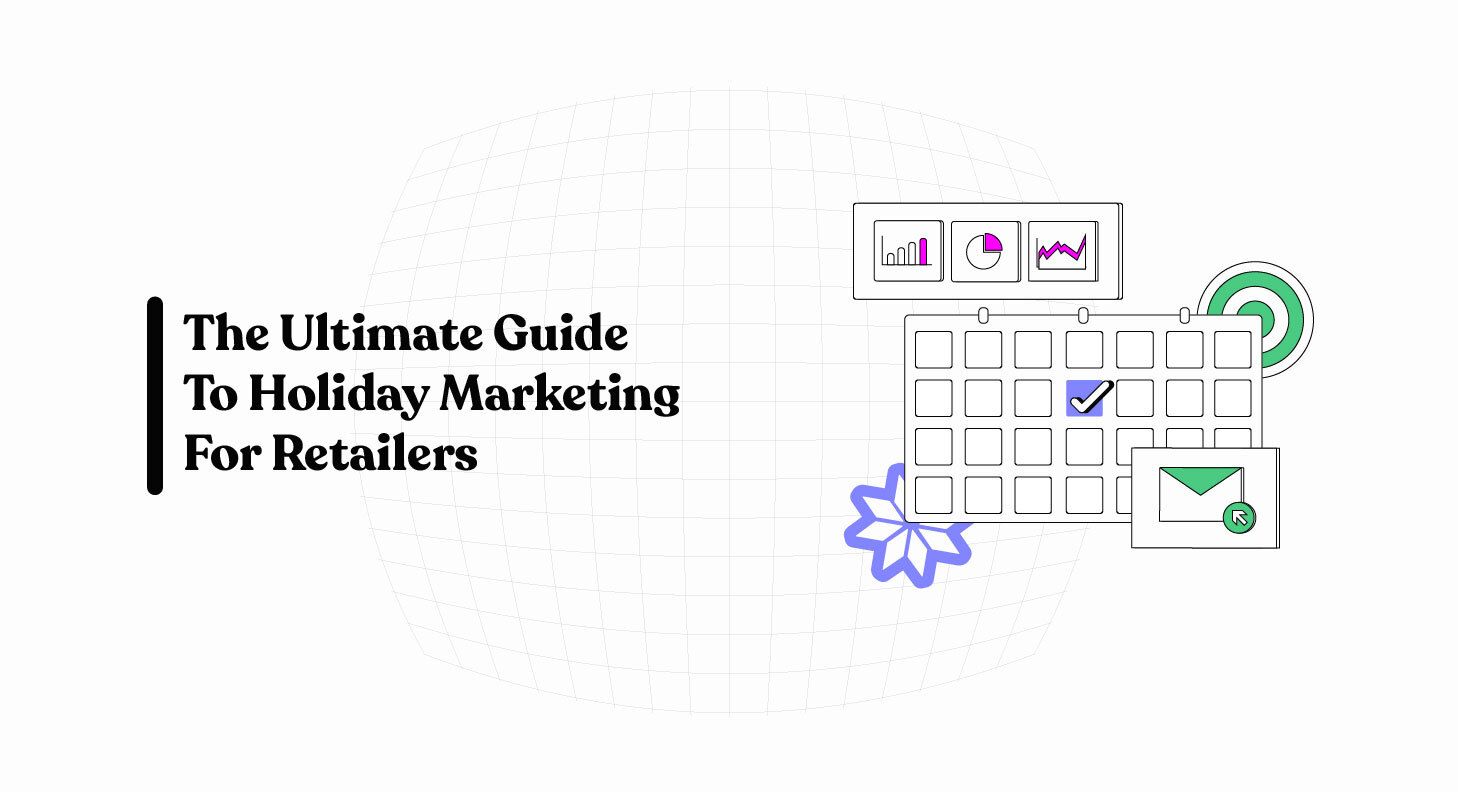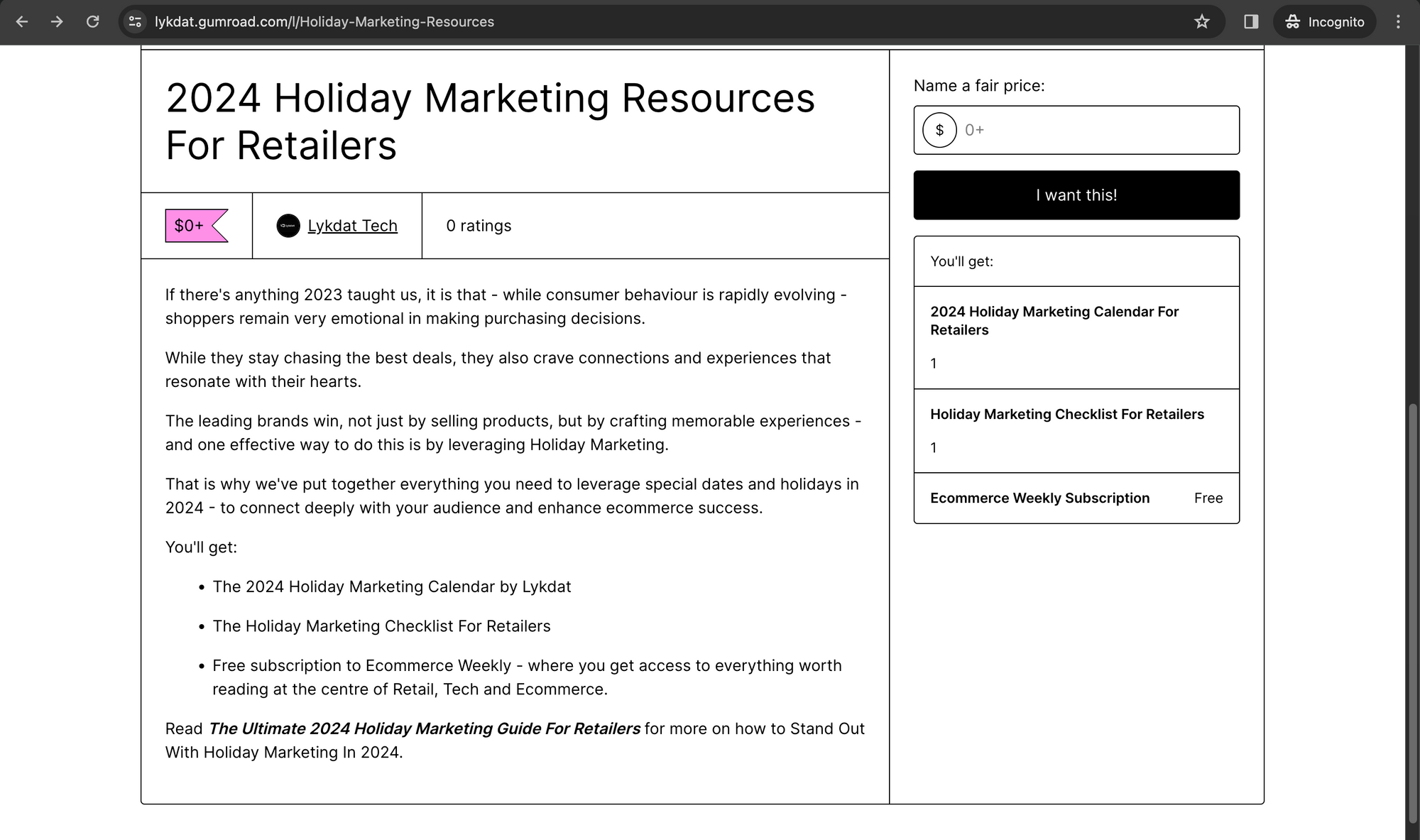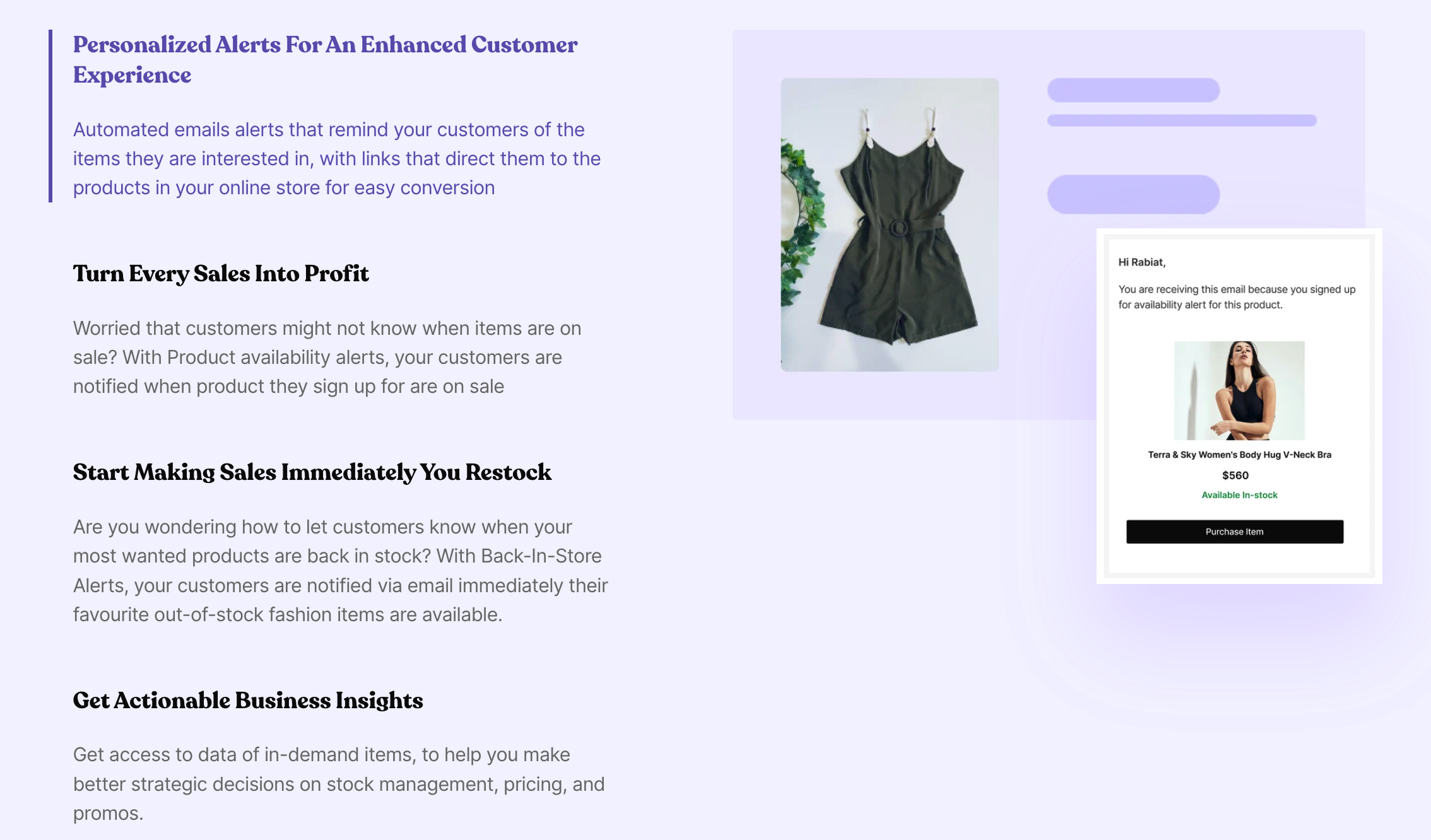The Ultimate 2024 Holiday Marketing Guide
This in-depth guide comes with a FREE Holiday Marketing Calendar and other valuable resources to help retailers connect deeper with their customers for a more successful 2024.

If there's anything 2023 taught us, it is that - while consumer behaviour is rapidly evolving - shoppers remain very emotional in making purchasing decisions.
While they stay chasing the best deals, they also crave connections and experiences that resonate with their hearts. In a world where algorithms whisper purchase suggestions and social media feeds overflow with curated "perfection", authenticity and emotional resonance remain the currency of retail.
Here's the reality: shoppers are tired of being bombarded with generic ads and soulless sales pitches. As many as 45% of shoppers will unfollow a brand on social media if the brand self-promotes too much. Consumers crave brands that speak their language, understand their values, and make them feel something beyond the fleeting thrill of a discount. As a matter of fact, 90% of customers say they are willing to pay more for a brand they trust. Shoppers yearn for experiences that create memories, spark joy, and solidify a connection with the brands they choose to invest in.
This is where the power of special dates and holidays comes into play. These aren't just calendar markings; they're opportunities to build bridges with your customers on an emotional level.
Let's explore how you can leverage special dates and holidays to connect deeply with your customers in 2024, and leverage that connection for enhanced retail success.
Keep reading!
How To Stand Out With Holiday Marketing In 2024
In 2024, the brands that win will be the ones who connect, not just sell. They'll be the ones who weave stories into the fabric of holidays, creating memories that last long after the excitement fades. Here's what you need to do:
1. Understand Your Target Audience
Consider your target audience as a woman you are interested in, and are trying to woo. You need to connect with her on an emotional level by understanding her interests and hopes, dreams and fears.
What values and traditions does she cherish? What sparks her joy during the holidays? What does she want to feel during this time of year, and how can your products or services help her achieve that?
Imagine her on Christmas morning, unwrapping a gift from your brand. Is it a spark of excitement, a wave of nostalgia, a feeling of empowerment, or perhaps a touch of luxurious comfort? Paint a vivid picture of her emotional response, and then tailor your marketing messages, product offerings, and customer experiences to make that vision a reality.
Go beyond demographics and delve into her desires. Is she a busy professional seeking a stress-free holiday experience? A bargain-hunter chasing the biggest discounts? A family-oriented soul looking for heartwarming traditions? A trendsetter eager to make a statement? Understanding her emotional landscape is the key to unlocking a deeper connection and, ultimately, driving sales.
Remember, people buy from brands they feel a connection with. This holiday season, ditch the impersonal sales pitches and craft stories that resonate with your target audience's emotional core. Make them feel seen, understood, and valued, and watch their loyalty and engagement blossom like a poinsettia in December sunshine.
Here are some practical tips to help you understand your target audience's emotional drivers:
- Conducting surveys and focus groups.
- Analyzing customer data and purchase history.
- Following relevant social media conversations and trends.
- Staying informed about cultural shifts and evolving values.
By putting yourself in your target audience's shoes (or rather, her festive slippers), you'll be well-positioned to craft campaigns that resonate deeply and turn her into a loyal customer.
2. Identify Relevant Special Dates & Holidays
Once you've established a deep understanding of your target audience, the next step is to identify and leverage relevant special dates and holidays throughout the year. Just as remembering important dates strengthens a personal relationship, recognizing and celebrating key occasions enhances your connection with customers.
That's where a Holiday Marketing Calendar comes in...
A comprehensive calendar should encompass a range of dates and events that are relevant to your business and resonate with your target audience.
Special dates and holidays may have different meanings and significance across regions and cultures. Ensure your calendar reflects this diversity, allowing you to tailor campaigns that resonate with various segments of your audience.
Here are the key components that a Holiday Marketing Calendar should contain:
- Major Holidays: Recognize globally celebrated holidays such as Christmas, New Year's, Easter, and Thanksgiving. Include regional or cultural holidays that are significant to your target audience.
- Seasonal Changes: Highlight the beginning of each season (spring, summer, fall, winter). Consider weather-related changes and how they influence consumer behavior and preferences.
- E-commerce Events: Integrate major e-commerce events like Black Friday, Cyber Monday, Singles' Day, and Amazon Prime Day. These are high-traffic online shopping days, and provide you an opportunity to give shoppers the best deals.
- Niche Observances: Identify industry-specific events and observances relevant to your brand. For fashion retailers, this could include fashion weeks, sustainability awareness days, or events related to specific fashion trends. While Niche observances might not bring about instant increased sales, they provide you an opportunity to provide value related to the dates in the form of content marketing.
- Brand Milestones: Celebrate key milestones for your brand, such as anniversaries, product launches, or store openings. Use these occasions to engage with your audience and build brand loyalty.
- Cultural and Religious Observances: Acknowledge and respect cultural and religious holidays like Easter that hold significance for your customers.
- Industry Events and Trade Shows: Include dates for relevant industry events and trade shows. Participation in or acknowledgment of these events can enhance your brand's credibility and industry standing.
- Customer Appreciation Days: Designate days to express gratitude to your customers. You could pick a day during the Customer Service Week, or even take advantage of customer birthdays. You can offer exclusive discounts, rewards, or early access to new products.
- National Shopping Days: Acknowledge national shopping days that may be relevant to your industry. For example, Small Business Saturday or Buy Local campaigns.
By identifying and strategically incorporating relevant special dates and holidays into your retail calendar, you not only enhance the overall shopping experience for your customers but also position your brand as one that is attuned to their lifestyles and values. This proactive approach to the holiday marketing sets the stage for meaningful and impactful interactions throughout the year.
That is why we created the 2024 Holiday Marketing Calendar For Retailers, and other valuable resources to help your business succeed in 2024.

2024 Holiday Marketing Resources For Retailers
We've put together everything you need to leverage special dates and holidays in 2024 - to connect deeply with your audience and enhance ecommerce success.
You'll get:
- The 2024 Holiday Marketing Calendar by Lykdat
- The Holiday Marketing Checklist For Retailers
- Free subscription to Ecommerce Weekly - where you get access to everything worth reading at the centre of Retail, Tech and Ecommerce.
3. Plan Your Campaigns Ahead Of Time
Now that your retail calendar is set, the next crucial step is to plan your campaigns well in advance. This strategic approach to retail marketing ensures that your efforts are cohesive, well-executed, and aligned with the expectations of your target audience.
Here's how to effectively plan your holiday campaigns:
- Ensure Alignment With Business Goals: Understand your overarching business goals and tailor each campaign to contribute directly to these objectives. Whether it's boosting sales, increasing brand awareness, or launching a new product, every campaign should have a clear purpose.
- Ensure Thematic Consistency: Ensure that your campaigns align thematically with the occasion or event. Consistency in messaging, visuals, and offers helps create a seamless and memorable brand experience for your customers.
- Early Promotion and Buildup: Start building anticipation for your campaigns well in advance. One thing that the 2023 Winter Holiday Shopping period taught us is that shoppers are now more intentional about finding the best deals during festive seasons than ever. As high as 85% of shoppers who plan to shop online typically have tabs open when waiting for sales to begin. You want those open tabs to be for your products. Teasers, countdowns, and sneak peeks generate excitement, encouraging customers to look forward to your offerings.
- Multi-Channel Integration: Plan campaigns that span multiple channels, including social media, email, in-store promotions, and your website. Develop a detailed social media and email marketing calendar outlining the content, posting schedule, and engagement strategies for each campaign. Consistent and timely updates amplify your campaign's impact. This cohesive approach across channels maximizes your reach and engagement.
- Resource Planning: Plan and allocate resources efficiently. Identify the necessary budget, staffing requirements, and materials well ahead of time.
You should also put plans in place to efficiently handle order fulfilment, returns and refunds. You don’t want the shopping experience to leave a bad taste in the mouths of your shoppers because of inadequate preparation.
A proactive approach prevents last-minute rushes and ensures smooth execution. - Inventory Readiness: For retail businesses, ensure that your inventory is well-stocked to meet the potential surge in demand during promotional periods. Anticipate popular products and plan accordingly.
- Tech Infrastructure Readiness: Ensure that your website, e-commerce platform, and other technical infrastructure are ready to handle increased traffic. Smooth online experiences are essential for customer satisfaction. Even a slight boost in page speed (by 100ms) can increase conversions by 7%. It's also a no-brainer that your ecommerce strategy should be mobile first. In the Post-Black Friday issue of Ecommerce Weekly, we discussed why mobile optimisiation is crucial to ecommerce success now more than ever.
- Strategic Partnerships and Collaborations: Explore potential partnerships or collaborations with influencers, other brands, or organizations that align with your campaign themes. These collaborations can expand your reach and bring a fresh perspective to your campaigns. If you plan to collaborate with influencers or partners, initiate discussions early. Negotiating terms and planning content ahead of time allows for a more seamless integration of their contributions.
- Initiate Customer Engagement and Interaction: Integrate interactive elements into your campaigns to enhance customer engagement. Contests, polls, and user-generated content initiatives create a two-way conversation with your audience.
4. Provide Real Value
Obviously, you need to give shoppers attractive discounts. 15% of all Black Friday orders on Shopify were made across borders in 2023. This indicates that shoppers are now more intentional in seeking discounts and product availability. Consumers are now looking for the best deals, no matter where they are.
However, your discounts need to be reasonable in the sense that you don’t devalue your brand. The best discounts are those who will attract shoppers who can and will still buy from you even after your discount promos.
You can also leverage bundles, gifts with purchase, or even free express shipping, to create a stronger connection with shoppers. You should also consider pre-launch offers or exclusive access for loyal customers. This not only rewards your existing customer base but also creates a sense of exclusivity that can drive early engagement.
There is a huge reward in meeting consumers halfway. The most profitable brands ensure that they offer shoppers the best, earliest, and most accessible deals possible - especially during special events and holidays.

Product Alerts by Lykdat
The Products Alerts API by Lykdat helps retailers engage profitably with customers by automatically sending personalized email alerts to shoppers when their favourite items are available at a lower price.
With Product Alerts, every discount is an opportunity for immediate sales.
5. Connect Deeply With Storytelling
Storytelling is the most important ingredient for connecting deeply with your target audience. Consider brands like Nike, Apple, Coca-Cola and McDonalds. They share a deep connection with their customers, built on the foundation of storytelling. By intentionally infusing storytelling into your campaigns, you transform your products from commodities into characters, and your customers from mere consumers into engaged participants in a narrative.
Here's why and how you should leverage storytelling to connect deeply with your audience:
- Forging Emotional Connections: Narratives have the ability to humanize your brand. Share stories about the origin of your products, the people behind the scenes, or the journey of a particular collection. Humanizing your brand makes it relatable and fosters a sense of connection.
Craft narratives that evoke emotions. Whether it's joy, nostalgia, or inspiration, tapping into the emotional spectrum makes your brand memorable and creates a lasting impact on your audience. - Building A Brand Identity: Develop a cohesive brand story that encapsulates your values, mission, and unique selling proposition. Consistent storytelling across various touchpoints reinforces your brand identity and helps consumers understand what sets your brand apart.
You can introduce brand characters or ambassadors that embody the essence of your brand. This could be your founder, employees, or even fictional characters that represent the values and personality of your brand. - Showcasing Product Stories: If your products have a unique craftsmanship or origin story, showcase it. Detail the intricate processes involved in creating your products, emphasizing the dedication and passion that goes into each piece.
Share transformation stories related to your products. Whether it's a customer's style transformation or the journey of a product from concept to creation, these stories add depth and context. - Engaging in Seasonal Narratives: Tailor your narratives to align with the themes of specific seasons, holidays, or events. Create stories that resonate with the sentiments and aspirations of your audience during these periods. Create a culture of storytelling that causes your customers to look forward to hearing from you, especially during special events and holidays.
- Customer-Centric Stories: Nothing inspires shoppers to take valuable actions like the unfiltered voice of customers. Encourage your customers to contribute to your brand story. Share user-generated content that showcases how your products integrate into their lives. This not only provides authenticity but also celebrates your community.
- Carry Out Testing: Conduct A/B testing on different elements of your campaigns, such as email subject lines, ad creatives, or promotional offers. This allows you to identify the most effective strategies and optimize for maximum impact.
- Measure Impact and Iterate: Utilize analytics and customer feedback to measure the impact of your storytelling efforts. Track engagement metrics, conversion rates, and sentiment analysis to understand how your stories resonate with your audience.
Based on insights gathered, iterate and refine your storytelling strategy. Be responsive to what works and what doesn't, and continuously evolve your narratives to meet the evolving expectations of your audience.
Through the art of storytelling, your brand becomes not just a product provider but a storyteller that invites customers to be part of a narrative that unfolds with every interaction.
6. Measure Impact
As festive seasons unfold and your holiday marketing campaigns reach their zenith, the next crucial step is to measure the impact of these endeavors. Effectively assessing the success of your campaigns goes beyond merely counting likes and shares—it involves extracting meaningful insights that inform future strategies.
Here's how to turn measure the impact of your marketing campaigns:
- Quantify Return on Investment (ROI): Measure the direct impact on sales generated by your holiday campaigns. Track revenue, conversion rates, and average order value to quantify the financial success of your initiatives.
Assess the costs associated with each campaign, including advertising expenses, creative production, and platform fees. Calculate the ROI by comparing the revenue generated against the total costs. - Evaluate Customer Engagement: Examine social media engagement metrics such as likes, shares, comments, and click-through rates. Identify which content resonated most with your audience and contributed to increased engagement. Evaluate the success of your email campaigns by analyzing open rates, click-through rates, and conversion rates. Understand which email subject lines, visuals, and offers had the most significant impact.
- Assess Website and E-commerce Analytics: Analyze website traffic during the campaign period. Identify which channels drove the most visitors and assess the overall increase in website visits compared to non-campaign periods.
Use tools like Google Analytics to analyze the conversion funnel. Understand how users moved from awareness to conversion, pinpointing areas of the funnel that may need optimization. - Gather Customer Feedback: Leverage surveys and customer reviews to gather direct feedback. Inquire about their experiences with your holiday campaigns, their preferences, and any suggestions for improvement. Customer reviews will also highlight what shoppers think about your products and other aspects of your business.
Monitor social media for mentions, hashtags, and sentiment analysis related to your holiday campaigns. Social listening provides insights into how customers perceive and discuss your brand. - Measure Brand Sentiment: Utilize sentiment analysis tools to gauge the overall sentiment around your brand during the holiday season. Positive sentiment indicates a successful campaign, while negative sentiment may signal areas for improvement.
Track the volume and context of brand mentions across online platforms. An increase in positive mentions suggests heightened brand awareness and resonance. - Evaluate Influencer Collaboration Impact: If your holiday campaigns involved influencers, assess the reach and engagement of their content. Evaluate how their audience responded to the collaborations and whether it translated into increased brand interest.
If possible, attribute conversions directly to influencer collaborations. Understand the impact each influencer had on driving customer actions. - Compare Performance Across Channels: If your campaigns spanned multiple channels (social media, email, website, etc.), compare performance across these channels. Identify which channels were most effective and allocate resources accordingly in future campaigns.
Explore how users interact across different platforms. A cohort analysis helps identify patterns of behavior and preferences among users who engaged with your campaigns across various channels. - Iterate Based on Insights: Pinpoint the elements that contributed most to the success of your holiday campaigns. Whether it's specific messaging, visuals, or promotional offers, identify the success factors to replicate in future initiatives.
Acknowledge any shortcomings or areas of underperformance. Use these insights to refine strategies, addressing weaknesses and optimizing campaigns for enhanced performance. - Carry Out Post-Campaign Analysis: Extend your analysis beyond the campaign period to assess post-holiday performance. This will help you understand whether the momentum created during the festive season has a lasting impact on customer engagement and sales.
Analyzing customer retention rates post-holidays will help you dentify strategies to retain the influx of new customers acquired during the festive season.
By diligently measuring the impact of your holiday marketing campaigns, you transform data into actionable insights. These insights serve as a compass for future marketing endeavors, guiding your strategies toward continued growth and customer satisfaction.

Retail Intelligence by Lykdat
Powered by AI, Lykdat's Retail Intelligence systematically collects customer feedback and product data from relevant online sources, sifts through the noise and identifies key themes during analysis, and provides actionable insights valuable for fashion brands and manufacturers.
Conclusion
In summary, mastering holiday marketing requires a customer-centric playbook:
- Understanding your audience is the first step — personalizing campaigns for deeper resonance.
- Identifying relevant dates and aligning with cultural nuances broadens reach and ensures campaigns hit a personal chord.
- Planning ahead synchronizes efforts, creates anticipation, and optimizes resource allocation.
- Providing real value through discounts and bundles transforms transactions into meaningful interactions.
- Connecting deeply with storytelling builds emotional bonds, making brands memorable and fostering customer loyalty.
- Measuring impact is the final frontier, turning campaigns into iterative processes. Analytics, feedback, and sentiment analysis provide insights for future strategies, turning each holiday season into a stepping stone for success.
In 2024, e-commerce triumphs not just by selling products but by crafting memorable experiences. By understanding your audience's aspirations, crafting experiences around key dates, and weaving stories that resonate with their hearts, you've created a marketing symphony that will leave them humming your brand tune long after the holidays fade.
Remember, real value goes beyond discounts and bundles; it lies in fostering emotional connections and leaving a lasting impression.

